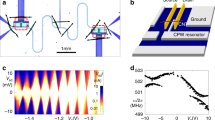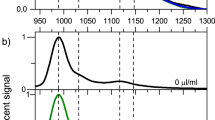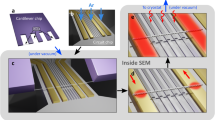Abstract
Two electrons on a string form a simple model system where Coulomb interactions are expected to play an interesting role. In the presence of strong interactions, these electrons are predicted to form a Wigner molecule, separating to the ends of the string. This spatial structure is believed to be clearly imprinted on the energy spectrum, yet so far a direct measurement of such a spectrum in a controllable one-dimensional setting is still missing. Here we use an ultraclean carbon nanotube to realize this system in a tunable potential. Using tunnelling spectroscopy we measure the addition spectra of two interacting carriers, electrons or holes, and identify seven low-energy states characterized by their exchange symmetries. The formation of a Wigner molecule is evident from a tenfold quenching of the fundamental excitation energy as compared with the non-interacting value. Our ability to tune the two-carrier state in space and to study it for both electrons and holes provides an unambiguous demonstration of this strongly interacting quantum ground state.
This is a preview of subscription content, access via your institution
Access options
Subscribe to this journal
Receive 12 print issues and online access
$209.00 per year
only $17.42 per issue
Buy this article
- Purchase on Springer Link
- Instant access to full article PDF
Prices may be subject to local taxes which are calculated during checkout




Similar content being viewed by others
References
Bryant, G. Electronic structure of ultrasmall quantum-well boxes. Phys. Rev. Lett. 59, 1140–1143 (1987).
Häusler, W. & Kramer, B. Interacting electrons in a one-dimensional quantum dot. Phys. Rev. B 47, 16353–16357 (1993).
Meyer, J. S. & Matveev, K. A. Wigner crystal physics in quantum wires. J. Phys. Condens. Matter 21, 023203 (2009).
Egger, R. & Gogolin, A. Effective low-energy theory for correlated carbon nanotubes. Phys. Rev. Lett. 79, 5082–5085 (1997).
Kane, C., Balents, L. & Fisher, M. Coulomb interactions and mesoscopic effects in carbon nanotubes. Phys. Rev. Lett. 79, 5086–5089 (1997).
Bockrath, M. et al. Luttinger-liquid behaviour in carbon nanotubes. Nature 397, 598–601 (1999).
Yao, Z., Postma, H. W. C., Balents, L. & Dekker, C. Carbon nanotube intramolecular junctions. Nature 402, 540–544 (1999).
Ishii, H. et al. Direct observation of Tomonaga–Luttinger-liquid state in carbon nanotubes at low temperatures. Nature 426, 540–544 (2003).
Jarillo-Herrero, P., Sapmaz, S., Dekker, C., Kouwenhoven, L. P. & Van Der Zant, H. S. J. Electron-hole symmetry in a semiconducting carbon nanotube quantum dot. Nature 429, 389–392 (2004).
Minot, E. D., Yaish, Y., Sazonova, V. & McEuen, P. L. Determination of electron orbital magnetic moments in carbon nanotubes. Nature 428, 536–539 (2004).
Cao, J., Wang, Q. & Dai, H. Electron transport in very clean, as-grown suspended carbon nanotubes. Nature Mater. 4, 745–749 (2005).
Deshpande, V. V. & Bockrath, M. The one-dimensional Wigner crystal in carbon nanotubes. Nature Phys. 4, 314–318 (2008).
Kuemmeth, F., Ilani, S., Ralph, D. C. & McEuen, P. L. Coupling of spinand orbital motion of electrons in carbon nanotubes. Nature 452, 448–452 (2008).
Steele, G. A., Gotz, G. & Kouwenhoven, L. P. Tunable few-electron double quantum dots and Klein tunnelling in ultraclean carbon nanotubes. Nature Nanotechnol. 4, 363–367 (2009).
Ellenberger, C. et al. Excitation spectrum of two correlated electrons in a lateral quantum dot with negligible Zeeman splitting. Phys. Rev. Lett. 96, 126806 (2006).
Kalliakos, S. et al. A molecular state of correlated electrons in a quantum dot. Nature Phys. 4, 467–471 (2008).
Singha, A. et al. Correlated electrons in optically tunable quantum dots: Building an electron dimer molecule. Phys. Rev. Lett. 104, 246802 (2010).
Kristinsdóttir, L. et al. Signatures of Wigner localization in epitaxially grown nanowires. Phys. Rev. B 83, 041101(R) (2011).
Jespersen, T. S. et al. Gate-dependent spin–orbit coupling in multielectron carbon nanotubes. Nature Phys. 7, 348–353 (2011).
Pei, F., Laird, E. A., Steele, G. A. & Kouwenhoven, L. P. Valley-spin blockade and spin resonance in carbon nanotubes. Nature Nanotechnol. 7, 630–634 (2012).
Secchi, A. & Rontani, M. Coulomb versus spin–orbit interaction in few-electron carbon-nanotube quantum dots. Phys. Rev. B 80, 041404(R) (2009).
Wunsch, B. Few-electron physics in a nanotube quantum dot with spin–orbit coupling. Phys. Rev. B 79, 235408 (2009).
Pályi, A. & Burkard, G. Spin-valley blockade in carbon nanotube double quantum dots. Phys. Rev. B 82, 155424 (2010).
Secchi, A. & Rontani, M. Wigner molecules in carbon-nanotube quantum dots. Phys. Rev. B 82, 035417 (2010).
Von Stecher, J., Wunsch, B., Lukin, M., Demler, E. & Rey, A. M. Double quantum dots in carbon nanotubes. Phys. Rev. B 82, 125437 (2010).
Kuemmeth, F., Churchill, H. O. H., Herring, P. K. & Marcus, C. M. Carbon nanotubes for coherent spintronics. Mater. Today 13, 18–26 (March, 2010).
Ingerslev Jørgensen, H. et al. Singlet–triplet physics and shell filling in carbon nanotube double quantum dots. Nature Phys. 4, 536–539 (2008).
Churchill, H. O. H. et al. Relaxation and dephasing in a two-electron 13C nanotube double quantum dot. Phys. Rev. Lett. 102, 166802 (2009).
Churchill, H. O. H. et al. Electron–nuclear interaction in 13C nanotube double quantum dots. Nature Phys. 5, 321–326 (2009).
Laird, E., Pei, F. & Kouwenhoven, L. A valley-spin qubit in a carbon nanotube. Preprint at http://arxiv.org/abs/1210.3085 (2012).
Rontani, M., Cavazzoni, C., Bellucci, D. & Goldoni, G. Full configuration interaction approach to the few-electron problem in artificial atoms. J. Chem. Phys. 124, 124102 (2006).
Acknowledgements
We would like to acknowledge E. Berg, A. Stern, A. Yacoby and B. Wunsch for useful discussions. S.I. acknowledges the financial support by the ISF Legacy Heritage foundation (2005/08-80.0), the Bi-National science foundation (BSF 710647-03), the Minerva foundation, the ERC starters grant (258753), the Marie Curie People grant (IRG 239322), and the Alon fellowship. S.I. is incumbent of the William Z. and Eda Bess Novick career development chair. P.L.M. and D.C.R. acknowledge support by the NSF through the Center for Nanoscale systems (EEC-0646547), by the NSF through DMR-1010768, and by the MARCO Focused Research Center on Materials, Structures and Devices. The experiments used the facilities of the Cornell node of the National Nanotechnology Infrastructure Network (EECS-0335765) and the Cornell Center for Materials Research (DMR-1120296), both funded by NSF. M.R. and A.S. acknowledge support from Fondazione Cassa di Risparmio di Modena through the project COLD and FEW, from EU through the Marie Curie ITN INDEX, and from the CINECA-ISCRA supercomputing grant IscrC_TUN1DFEW. F.K. acknowledges support by the Center for Quantum Devices, funded by the Danish National Research Foundation.
Author information
Authors and Affiliations
Contributions
F.K., S.I., D.C.R. and P.L.M. conceived and designed the experiments. F.K. and S.I. performed the experiments. S.P., A.S. and M.R. provided theoretical tools for analysing the data. S.P., F.K., A.S., M.R. and S.I. analysed the data. S.P. and S.I. wrote the manuscript and all authors contributed to its final version.
Corresponding author
Ethics declarations
Competing interests
The authors declare no competing financial interests.
Supplementary information
Supplementary Information
Supplementary Information (PDF 758 kb)
Rights and permissions
About this article
Cite this article
Pecker, S., Kuemmeth, F., Secchi, A. et al. Observation and spectroscopy of a two-electron Wigner molecule in an ultraclean carbon nanotube. Nature Phys 9, 576–581 (2013). https://doi.org/10.1038/nphys2692
Received:
Accepted:
Published:
Issue Date:
DOI: https://doi.org/10.1038/nphys2692
This article is cited by
-
Nano-assembled open quantum dot nanotube devices
Communications Materials (2024)
-
Vortex structure in Wigner molecules
Scientific Reports (2023)
-
Wigner-molecularization-enabled dynamic nuclear polarization
Nature Communications (2023)
-
Long-lived electronic spin qubits in single-walled carbon nanotubes
Nature Communications (2023)
-
Electronic thermal transport measurement in low-dimensional materials with graphene non-local noise thermometry
Nature Nanotechnology (2022)



